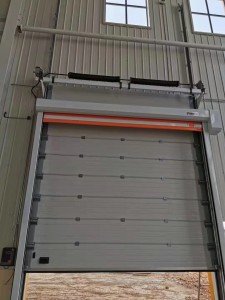What is the difference between lifting door and stacking door
As two common types of industrial doors, lifting doors and stacking doors each have unique characteristics and applicable scenarios. They have significant differences in material structure, opening method, functional characteristics, and application areas. Next, we will compare the two types of doors in detail to better understand the difference between them.
First of all, from the perspective of material structure, lifting doors usually use double-layer steel plates as door panels. This structure makes the door panels thicker and heavier, with strong impact resistance, and excellent anti-theft and wind resistance. The door panels are filled with high-density polyurethane foam, which has good insulation effect and constant temperature and humidity. The stacking door uses PVC door curtains and is equipped with multiple built-in or external transverse wind-resistant rods, which have strong wind resistance. The door panel is light and can be automatically stacked or unfolded through the cooperation of rollers and tracks to meet the needs of frequent opening.
Secondly, in terms of opening method, lifting doors are usually driven by motors, and the entire door panel rises and falls along the guide rails. This opening method requires a certain amount of space, and due to its own heavy weight, the opening speed is relatively slow. The stacking door, on the other hand, uses the cooperation of the roller and the track to make the door panels unfold or stack in the horizontal direction, so as to achieve fast opening and closing. This opening method is more flexible and suitable for occasions that need to be opened and closed frequently.
In terms of functional characteristics, the lifting door has the characteristics of vertical upward opening, no indoor space occupation, thermal insulation, noise isolation, strong wind resistance and excellent air tightness. This type of door is usually designed according to the characteristics of the building structure and is hung flat on the inner side of the wall above the door opening to release the door opening space. The stacking door has the advantages of thermal insulation and energy saving, sealing and isolation, high safety performance, fast opening speed and space saving. Its unique sealing system can effectively block the movement of cold and hot air, prevent the entry of external dust and insects, and isolate the spread of odor and noise.
Finally, from the perspective of application areas, the lifting door is usually used in occasions with high security requirements, such as warehouses and factories, due to its strong impact resistance and anti-theft performance. The stacking door is widely used in food, chemical, textile, refrigeration, electronics, printing, supermarket refrigeration assembly, precision machinery, logistics warehousing and other places due to its fast opening speed, space saving and excellent sealing performance. It is suitable for logistics channels and large-area openings and other occasions that need to be opened and closed quickly.
In summary, there are obvious differences between lifting doors and stacking doors in terms of material structure, opening method, functional characteristics and application fields. When choosing an industrial door, you should choose the appropriate type according to the specific usage scenario and needs. For example, for occasions that require higher security and thermal insulation performance, lifting doors may be more suitable; while for occasions that require frequent opening and closing and space saving, stacking doors may have more advantages. By deeply understanding the difference between the two types of doors, we can better meet actual needs and improve the efficiency and safety of industrial doors.
